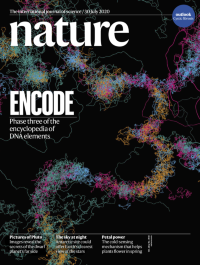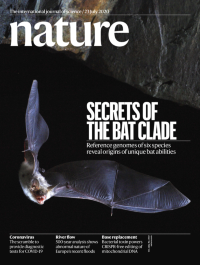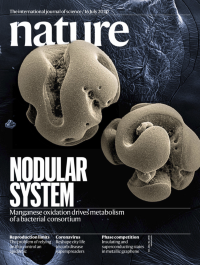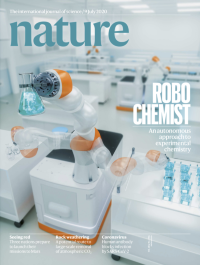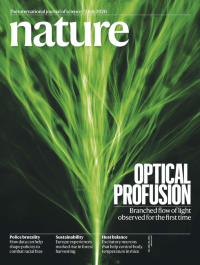Volume 583
-
No. 7818 30 July 2020
ENCODEThis week marks the publication of results from phase three of the Encyclopedia of DNA Elements (ENCODE) project. Nine articles in this issue of Nature, along with papers published online and in several other journals, examine the most comprehensive catalogue yet of the candidate functional elements in the human and mouse genomes. In an overview paper, the ENCODE Project Consortium offers a summary of the new elements in the encyclopedia, which have been compiled with data sets from some 6,000 experiments. Much of the work published in this issue examines DNA regions called candidate cis-regulatory elements (cCREs), which may regulate gene transcription. Three papers — from Joseph Ecker, Bing Ren, Barbara Wold and their colleagues — look at cCREs during embryonic development in the mouse. Two papers from Wouter Meuleman, Jeff Vierstra, John Stamatoyannopoulos and colleagues map cCREs and transcription factor footprints in hundreds of human cell and tissue types. Michael Snyder and colleagues map chromatin loops in 24 human cell types; Eric Mendenhall and co-workers map the genome-wide binding of almost one-quarter of all chromatin-associated proteins active in a human liver cell line; and Brenton Graveley and colleagues integrate multiple assays to produce a comprehensive analysis of RNA-binding proteins and their functional elements. Finally, in a Perspective article, the project team puts the multiple phases of ENCODE in context.
Nature Outlook
-
No. 7817 23 July 2020
Secrets of the bat cladeBats have evolved some extraordinary adaptations including echolocation, exceptional longevity and a unique immune system. In this week’s issue, Emma Teeling, Sonja Vernes and their colleagues present reference-quality genomes for six species of bat sequenced by the Bat1K consortium. Together, these sequences help provide insights into the evolutionary origins and molecular basis of bat adaptations. The researchers identified the phylogenetic position of bats in mammals, show that genes involved in hearing were selected for in the ancestral branch of bats, and they provide evidence for the molecular mechanisms that may have contributed to bats’ exceptional immune system. The genomes should also aid studies of how bats tolerate coronavirus infections, which may, in the future, yield approaches to increase the human survivability of diseases such as COVID-19.
-
No. 7816 16 July 2020
Nodular systemIt has long been suggested that microbes might exist that can derive their energy needs from the oxidation of manganese. In this week’s issue, Hang Yu and Jared Leadbetter present a co-culture of two bacterial species that can use free energy from manganese oxidation to drive both their growth and the fixation of inorganic carbon into biomass. In so doing, the bacteria generate the discrete, macroscopic nodules of manganese oxide shown on the cover. The two species — designated as ‘Candidatus Manganitrophus noduliformans’ and Ramlibacter lithotrophicus by the researchers — grow together as manganese autotrophs. The first species has not yet been isolated from the second, and the second does not oxidize manganese when isolated. The discovery increases the number of known inorganic metabolisms that support life, and has implications for understanding the formation of manganese nodules on the deep-sea floor.
-
No. 7815 9 July 2020
Robo chemistAutomation is on the rise in chemistry laboratories, but to date this tends to involve custom-made automated instruments or bespoke interfaces to allow robotic arms to work with lab equipment. In this week’s issue, Andrew Cooper and his colleagues show that a mobile robot that might be found in a car-assembly line can be modified to operate alongside humans in a wet chemistry lab, and can use the same instruments as a human chemist. The team programmed the robot with the objective of improving the performance of a polymeric photocatalyst. Over the course of eight days, the robot autonomously performed 688 experiments and identified photocatalyst mixtures that were six times more active than the initial formulations — a task that would have taken humans several months. By automating the researcher rather than the instruments, the team says its approach could find multiple applications in chemistry labs.
-
No. 7814 2 July 2020
Optical profusionBranched flow occurs when waves travel through complex environments and form channels with enhanced intensity, which then keep dividing as the waves propagate. The phenomenon was first seen in electrons and has been suggested as a mechanism for focusing sound and ocean waves. In this week’s issue, a collaboration between the Technion in Israel and the University of Central Florida presents the first experimental observation of branched flow of light. The flow was seen propagating inside a thin soap membrane, in which variations in membrane thickness focused the light into branched filaments (pictured). The ability to create branched flow in the field of optics offers fresh opportunities for investigating and understanding this phenomenon.

